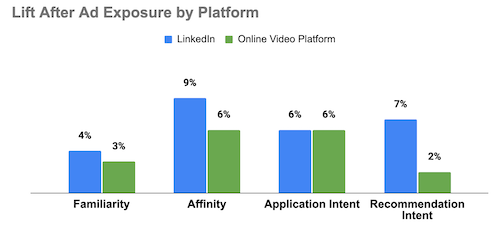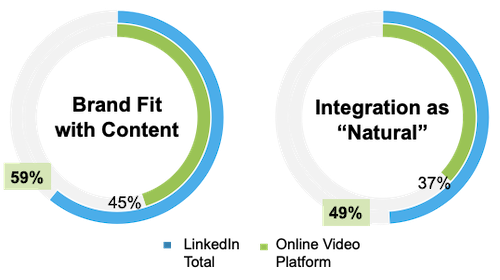Study: How Higher Education Marketing Campaigns Can Reach the Right Audience at the Right Time
As an Account Executive at LinkedIn, I’ve observed that both Higher Education and Media have a lot in common, as both are important ways that our society learns and grows. They also present consumers with a broad array of options of where they should invest their valuable time and money.
With so many options across both Higher Education and Media, it is critical to ensure your Higher Education marketing strategy is efficiently leveraging media allocation to maximize its reach to key audiences. It is equally important to find those audiences at a time when they are open to this messaging.
To help provide guidance to Higher Education marketers, we commissioned a custom study from Nielsen, a global leader in providing audience-driven perspective that helps advertisers, agencies and media owners understand ways to reach prospective students. The research also explores how different media environments impact the ability of these ads to drive increased interest for brands.
This research included two key phases:
Reach Analysis*: This phase examined a historical Higher Education campaign that ran on both LinkedIn and TV. Nielsen then conducted an analysis that uses audience viewing data to estimate how reach would be impacted if spend was shifted from one media type to another.
Ad Impact Testing**: In this phase, Nielsen tested a set of ads from 5 Online Universities, with some consumers shown ads within a LinkedIn feed while others were shown ads within a mock-up of a major Online Video Platform. The consumer survey evaluated how well ads on these platforms were able to drive increased interest in the advertised Online Universities.
From this study, we found several key insights that marketers should consider when determining how to best allocate budgets for Higher Education campaigns.
Insight #1: Diversifying Spend Across TV and LinkedIn Can Help Expand Reach.
When examining the test campaign, the reach analysis showed that there was an opportunity to deliver greater reach to the target audience by reallocating budget from TV to LinkedIn. The test campaign had allocated 17% of spend to LinkedIn and 83% allocated to TV. However, the study found that the campaign could have delivered an additional 12% points of reach (going from 38% reach to 50% reach) by maintaining the same total spend but reallocating the budget so two-thirds was dedicated to LinkedIn.
One other interesting finding was how complementary the LinkedIn audience was to TV. The research showed a consistently small overlap in who was expected to be reached by TV and by LinkedIn across the projections. In the scenario that generated the greatest total campaign reach, only 18% of those expected to be reached by the campaign were likely to be reached by both TV and LinkedIn. This means that LinkedIn offered a great way to expand the reach of a TV buy while avoiding directing ads to those that were already reached by TV.
The net result of this reach analysis was that marketers should explore scenarios that balance spend between TV and LinkedIn in order to maximize the ability of campaigns to efficiently reach key target audiences.
Insight #2: LinkedIn Can Drive Greater Lift Than a General Market Video Platform.
In addition to providing expanded reach potential, exposure to ads in the LinkedIn environment also demonstrates a strong ability to drive improvements in consumer perceptions of Online Universities. On average across the 5 University ads tested, we saw that exposure to ads on LinkedIn was able to significantly improve claimed Familiarity, Affinity, Application Intent, and Recommending Intent.
Further, when we compared the lifts for ads within a LinkedIn environment versus a major Online Video Platform environment, we found that ads on LinkedIn were able to generate greater lifts in Affinity and Recommendation Intent, all while generating similar improvements in Familiarity and Application Intent for the advertised Online University.
Insight #3: Strong Outcomes for LinkedIn Are Likely Due To the Natural and Relevant Fit Offered by LinkedIn for Online University Advertising.
The ad impact research also provided insights into why LinkedIn is such an effective environment for Online University advertising. The research shows that those who were exposed to the ads in a LinkedIn environment were over 30% more likely to feel that the Online University ad was a good fit with the content and to see the ad integration as “Natural” when compared to those who saw the ad in an Online Video Platform environment.
Further, the ads seen in the LinkedIn environment were significantly more likely to be seen as Informative, Professional, and Credible. These dynamics are particularly important when consumers are choosing within this industry, given the relatively high investment of both time and money into higher education.
Overall, this research demonstrates that LinkedIn is able to offer a sizable incremental audience to TV a helping those campaigns be as successful as possible. Reach out to your expert LinkedIn team to learn how you can effectively include LinkedIn as part of your media strategy.
* Custom Nielsen Share Shift study commissioned by LinkedIn, 9/1/19-11/30/19, A20-45 non-students without a bachelor’s degree.
** Custom Nielsen Ad Format study commissioned by LinkedIn. Survey conducted from October 12-20, 2020. Sample of 1000 total respondents ages 20-45 non-students without a bachelor’s degree.
For more Education Marketing insights, subscribe to the LinkedIn Marketing Solutions blog.








